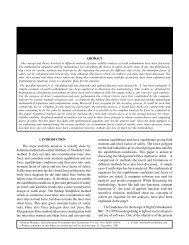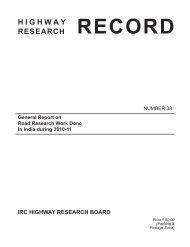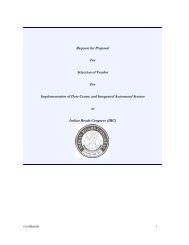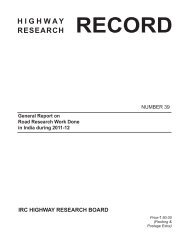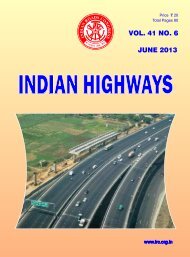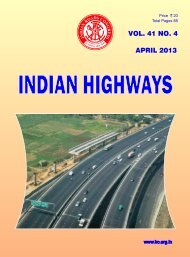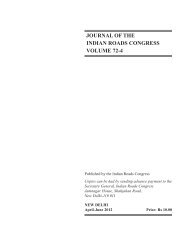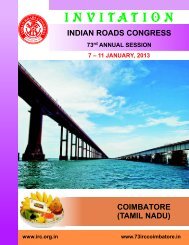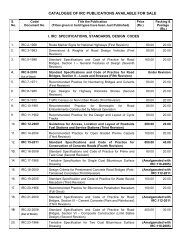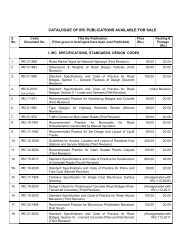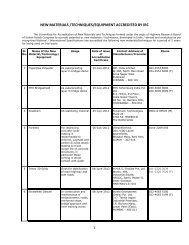Design and Construction of Pre-Tensioned Sutlej Bridge in Punjab
Design and Construction of Pre-Tensioned Sutlej Bridge in Punjab
Design and Construction of Pre-Tensioned Sutlej Bridge in Punjab
You also want an ePaper? Increase the reach of your titles
YUMPU automatically turns print PDFs into web optimized ePapers that Google loves.
158<br />
2. <strong>Construction</strong> aspect<br />
(a) Provision <strong>of</strong> track-l<strong>in</strong>e for gantries as proper<br />
embankment <strong>in</strong> the river bed;<br />
(b) Provision <strong>of</strong> temporary Service <strong>Bridge</strong> across the river;<br />
(c) Mechanisation <strong>of</strong> concret<strong>in</strong>g for pretensioned beam.<br />
(d) Use <strong>of</strong> large panel formwork for piers <strong>and</strong> beams;<br />
(e) Bear<strong>in</strong>g configuration, fix<strong>in</strong>g <strong>of</strong> bear<strong>in</strong>gs <strong>and</strong><br />
stabilisation <strong>of</strong> beams after the erection till the cast<strong>in</strong>g<br />
<strong>of</strong> diaphragms <strong>and</strong> deck slab;<br />
Many <strong>of</strong> the above design <strong>and</strong> construction aspects<br />
warrant <strong>in</strong> depth knowledge <strong>and</strong> meticulous micro plann<strong>in</strong>g to<br />
suit the adoption <strong>of</strong> particular type <strong>of</strong> technology.<br />
3. Proposal for codal guidel<strong>in</strong>es for pretension<strong>in</strong>g<br />
On the basis <strong>of</strong> design<strong>in</strong>g <strong>and</strong> execut<strong>in</strong>g long span<br />
pretensioned bridge spans, the authors propose the follow<strong>in</strong>g:<br />
(a) The m<strong>in</strong>imum dimensions <strong>of</strong> the cross section shall<br />
be<br />
(i) Thickness <strong>of</strong> top flange: 100 mm<br />
(ii) Thickness <strong>of</strong> bottom flange: 150 mm<br />
(iii) Thickness <strong>of</strong> web: 150 mm<br />
HEGGADE, MEHTA & PRAKASH ON<br />
DESIGN AND CONSTRUCTION OF PRE-TENSIONED SUTLEJ BRIDGE IN PUNJAB<br />
(b) The span to depth <strong>and</strong> depth to width ratios for<br />
optimum beam cross section from lateral stability<br />
considerations shall satisfy follow<strong>in</strong>g Factor Of<br />
Safeties<br />
(i) FOS with out cast<strong>in</strong>g imperfections > 2<br />
(ii) FOS with <strong>in</strong>itial imperfections > 1.5<br />
(iii) FOS with Actual angle <strong>of</strong> tilt > 1.1<br />
(c) Provided adequate un-tensioned re<strong>in</strong>forcements are<br />
designed for pre cast girder, the tension shall be<br />
permitted at the top fibre <strong>of</strong> the girder which may be<br />
restricted to 0.36(Fck) 0.5 .<br />
(d) The losses due to seat<strong>in</strong>g <strong>and</strong> friction are not<br />
applicable to pre tension<strong>in</strong>g. The elastic shorten<strong>in</strong>g<br />
loss shall be considered for a condition that all str<strong>and</strong>s<br />
are stressed at the same time <strong>and</strong> pre stress transfer to<br />
concrete is simultaneous. In case <strong>of</strong> pre tensioned<br />
girders relaxation losses start as soon as pretension<strong>in</strong>g<br />
is carried out, but the effect <strong>of</strong> which is transferred to<br />
concrete at the time <strong>of</strong> pre stress transfer due to which<br />
relaxation losses calculated as per IRC:18 shall be<br />
divided by 2 for assessment <strong>of</strong> actually available pre<br />
stress<strong>in</strong>g force at transfer. It is not necessary to<br />
consider 20 per cent additional time dependent losses<br />
for pre-tensioned girders.<br />
(e) Transmission length due to ‘Hoyer’s effect’ shall be<br />
considered to be 30 times the diameter <strong>of</strong> tendon.<br />
(f) <strong>Pre</strong> tension<strong>in</strong>g bench for long l<strong>in</strong>e cast<strong>in</strong>g shall be<br />
designed for 20 per cent additional capacity to<br />
overcome ‘Long L<strong>in</strong>e Bench Effect’.<br />
ACKNOWLEDGEMENTS<br />
The authors would like to place on record the s<strong>in</strong>cere thanks<br />
to honourable Manag<strong>in</strong>g Director, Jo<strong>in</strong>t Manag<strong>in</strong>g Director,<br />
Chief Eng<strong>in</strong>eer <strong>and</strong> his colleagues <strong>of</strong> <strong>Punjab</strong> Infrastructure<br />
Development Board (PIDB) without whose cooperation,<br />
guidance <strong>and</strong> encouragement, the successful completion <strong>of</strong><br />
this bridge would not have been possible. The authors would<br />
also like to thank all the eng<strong>in</strong>eers at H.O. <strong>and</strong> site <strong>of</strong> Gammon<br />
India Limited for their monumental efforts to construct such a<br />
large bridge with<strong>in</strong> a very short period.



